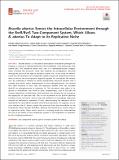| dc.contributor.author | Altamirano-Silva, Pamela | |
| dc.contributor.author | Meza-Torres, Jazmín | |
| dc.contributor.author | Castillo-Zeledón, Amanda | |
| dc.contributor.author | Ruiz-Villalobos, Nazareth | |
| dc.contributor.author | Zúñiga Pereira, Ana Mariel | |
| dc.contributor.author | Chacón-Díaz, Carlos | |
| dc.contributor.author | Moreno, Edgardo | |
| dc.contributor.author | Guzman-Verri, Caterina | |
| dc.contributor.author | Chaves-Olarte, Esteban | |
| dc.date.accessioned | 2020-10-13T16:47:58Z | |
| dc.date.available | 2020-10-13T16:47:58Z | |
| dc.date.issued | 2018-01-16 | |
| dc.identifier.uri | http://hdl.handle.net/11056/18332 | |
| dc.description.abstract | Brucella abortus is a facultative extracellular-intracellular pathogen belonging to a group of Alphaproteobacteria that establishes close interactions with animal cells. This bacterium enters host cells in a membrane-bound compartment, avoiding the lysosomal route and reaching the endoplasmic reticulum through the action of the type IV secretion system, VirB. In this work, we demonstrate that the BvrR/BvrS two-component system senses the intracellular environment to mount the transcriptional response required for intracellular life adaptation. By combining a method to purify intracellularly extracted bacteria with a
strategy that allows direct determination of BvrR phosphorylation, we showed that upon entrance to host cells, the regulatory protein BvrR was activated (BvrR-P) by phosphorylation at aspartate 58. This activation takes place in response to intracellular cues found in early compartments, such as low pH and nutrient deprivation. Furthermore, BvrR activation was followed by an increase in the expression of VjbR and VirB. The in vitro activation of this BvrR-P/VjbR/VirB virulence circuit rescued B. abortus from the inhibition of intracellular replication induced by bafilomycin treatment of cells, demonstrating the relevance of this mechanism for intracellular bacterial survival and replication. All together, our results indicate that B. abortus senses the transition from the extracellular to the intracellular milieu through BvrR/BvrS, allowing the bacterium to transit safely to its replicative niche. These results serve as a working model for understanding the role of this family of two-component systems in the adaptation to intracellular life of Alphaproteobacteria | es_ES |
| dc.description.abstract | Brucella abortus es un patógeno facultativo extracelular-intracelular perteneciente a un grupo de alfaproteobacterias que establece estrechas interacciones con las células animales. Esta bacteria entra en las células huéspedes en un compartimento unido a la membrana, evitando la ruta lisosómica y llegando al retículo endoplásmico por la acción del sistema de secreción de tipo IV, VirB. En este trabajo, demostramos que el sistema de dos componentes BvrR/BvrS detecta el entorno intracelular para montar la respuesta transcripcional necesaria para la adaptación de la vida intracelular. Combinando un método para purificar las bacterias extraídas intracelularmente con una estrategia que permite la determinación directa de la fosforilación de BvrR, demostramos que al entrar en las células huéspedes, la proteína reguladora BvrR fue activada (BvrR-P) por la fosforilación en el aspartato 58. Esta activación tiene lugar en respuesta a las señales intracelulares encontradas en los primeros compartimentos, como el bajo pH y la privación de nutrientes. Además, a la activación de BvrR le siguió un aumento de la expresión de VjbR y VirB. La activación in vitro de este circuito de virulencia BvrR-P/VjbR/VirB rescató a B. abortus de la inhibición de la replicación intracelular inducida por el tratamiento de las células con bafilomicina, lo que demuestra la importancia de este mecanismo para la supervivencia y la replicación de las bacterias intracelulares. En conjunto, nuestros resultados indican que B. abortus percibe la transición del medio extracelular al intracelular a través de BvrR/BvrS, permitiendo a la bacteria transitar con seguridad a su nicho de replicación. Estos resultados sirven como modelo de trabajo para comprender el papel de esta familia de sistemas de dos componentes en la adaptación a la vida intracelular de las alfaproteobacterias. | es_ES |
| dc.description.sponsorship | Universidad Nacional, Costa Rica | es_ES |
| dc.language.iso | eng | es_ES |
| dc.publisher | American Society for Microbiology. | es_ES |
| dc.rights | Acceso abierto | es_ES |
| dc.rights | Attribution-NonCommercial-NoDerivatives 4.0 Internacional | * |
| dc.rights.uri | http://creativecommons.org/licenses/by-nc-nd/4.0/ | * |
| dc.source | Infection and Immunity Vol. 86 No.4, 2018 | es_ES |
| dc.subject | BRUCELOSIS | es_ES |
| dc.subject | BRUCELLA | es_ES |
| dc.subject | TYPE IV SECRETION SYSTEM | es_ES |
| dc.subject | BACTERIAS | es_ES |
| dc.subject | BRUCELLA ABORTUS | es_ES |
| dc.title | Brucella abortus senses the intracellular environment through the BvrR/Bvrs two-component system, which allows B. abortus to adapt to its replicative nich | es_ES |
| dc.type | http://purl.org/coar/resource_type/c_6501 | es_ES |
| dc.description.procedence | Escuela de Medicina Veterinaria | es_ES |
| dc.identifier.doi | https://doi.org/10.1128/IAI.00713-17. | |


